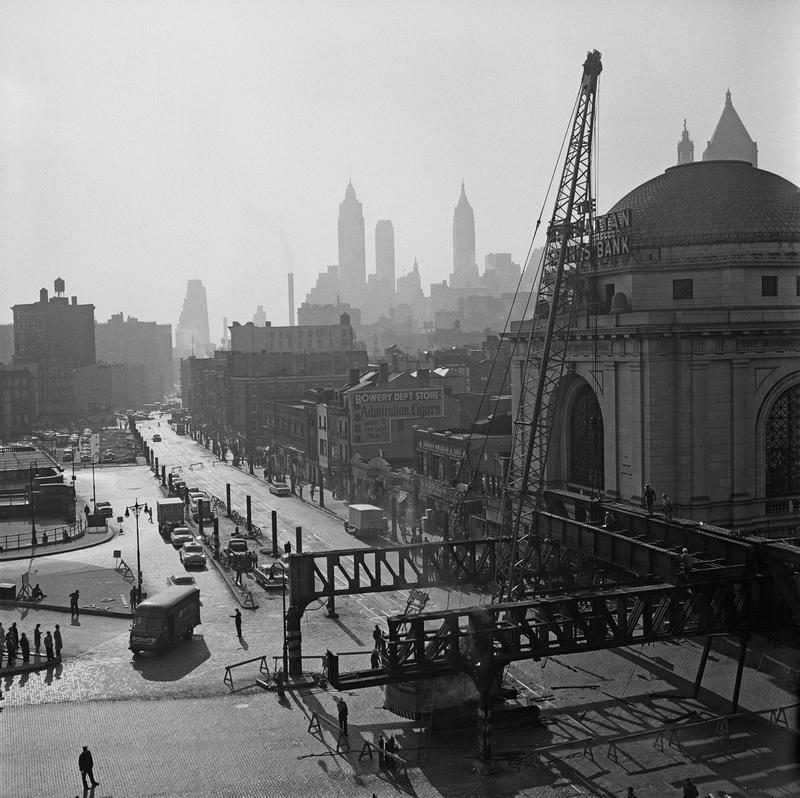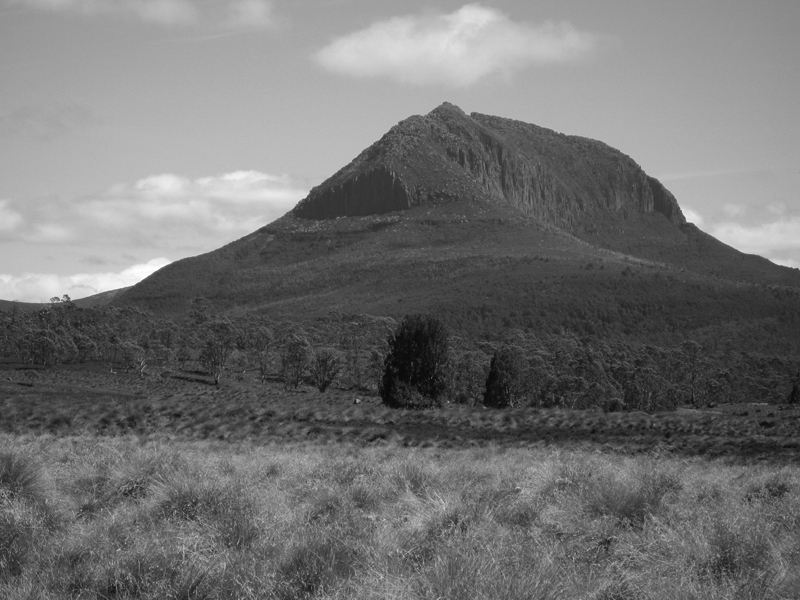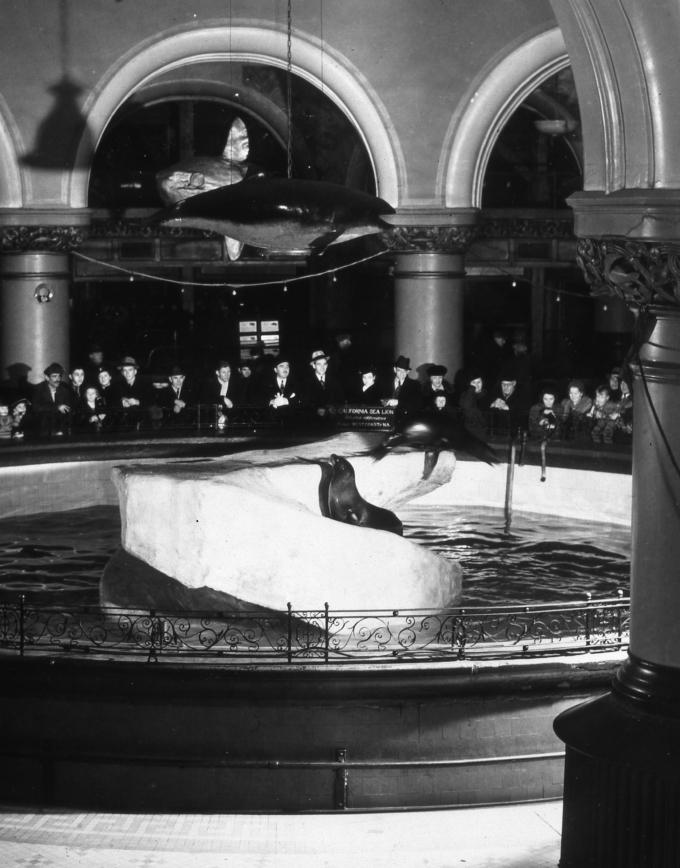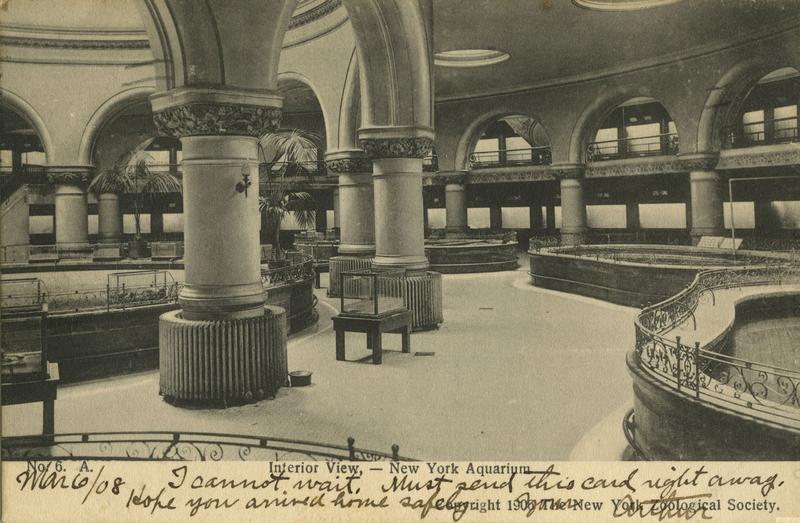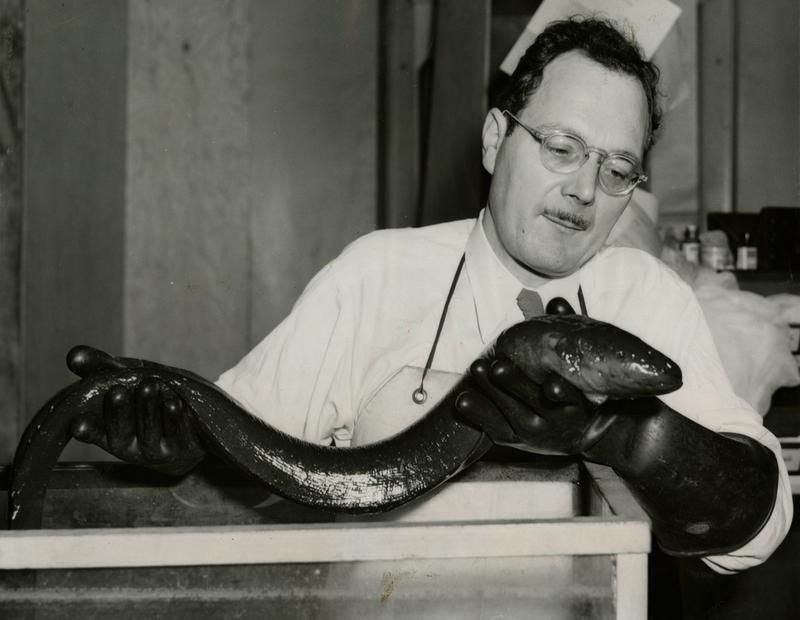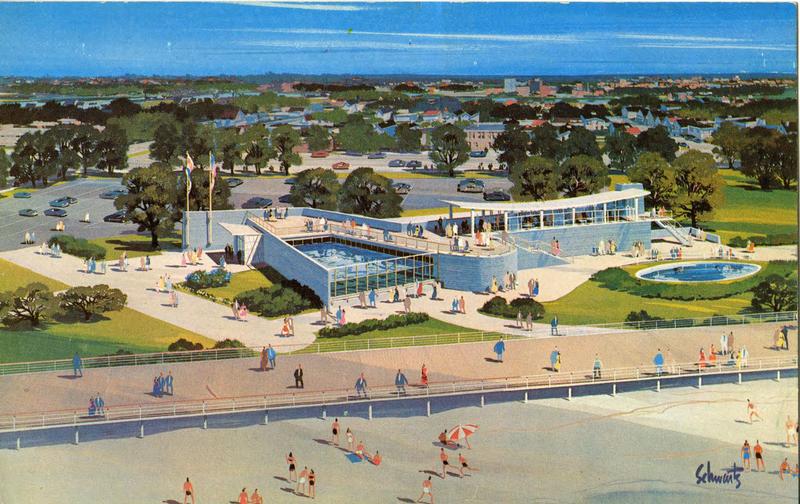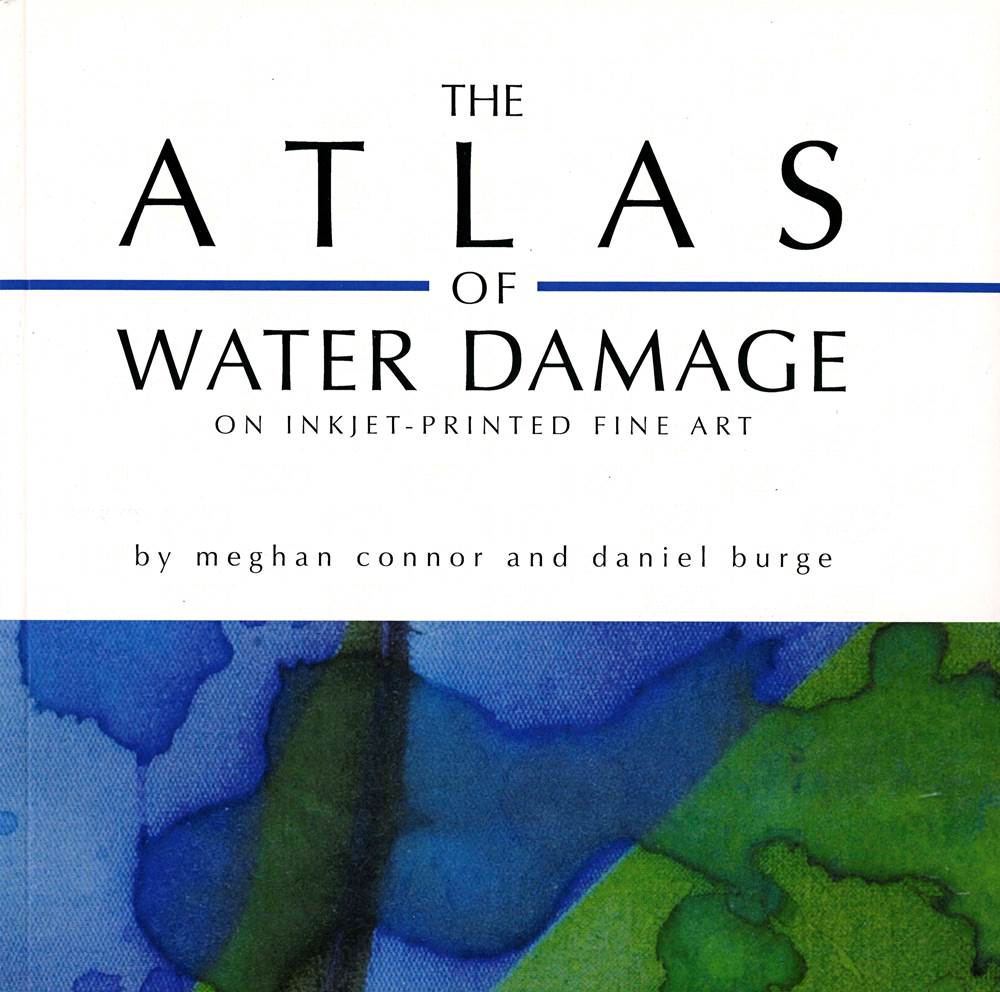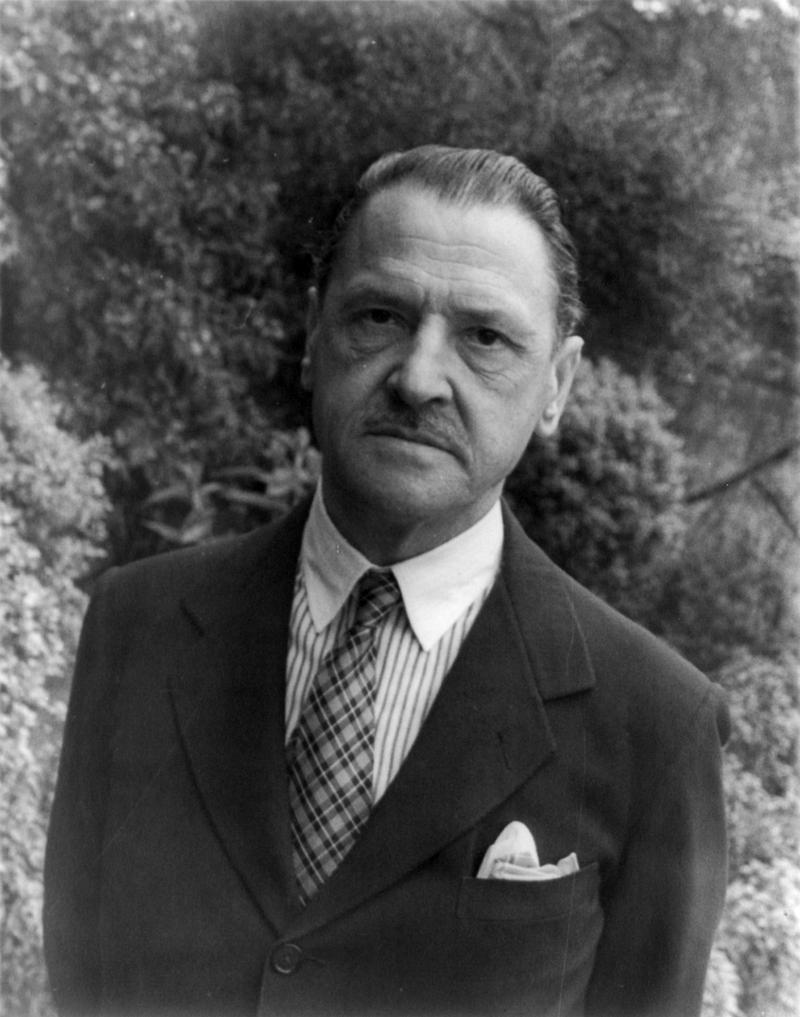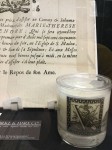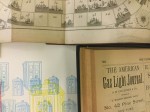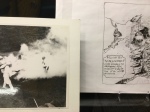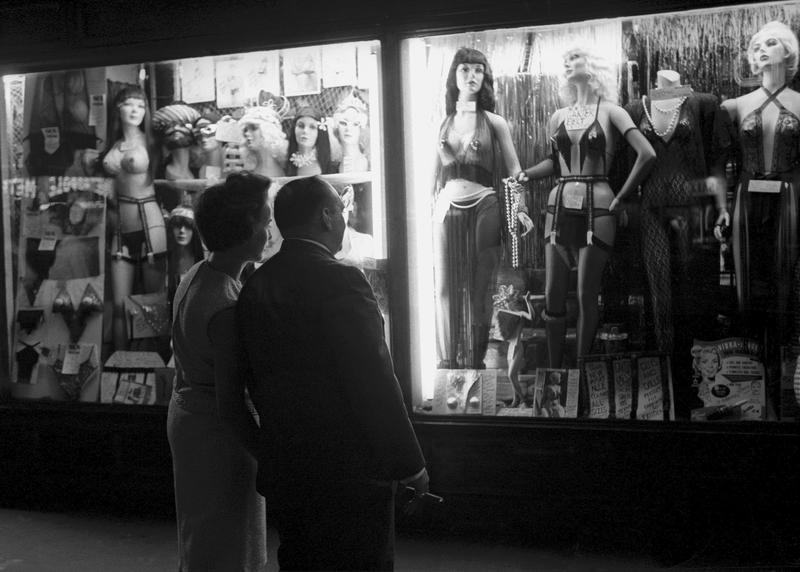Kurz notiert: Während der Olympischen Spiele 2016 in Rio de Janeiro präsentiert das Bundesarchiv auf seiner Webseite jeden Tag ein historisches Foto aus den Beständen seines Bildarchivs. Zu sehen gibt es unter anderem ein Siegfoto der Schwimmerin Kristin Otto. In Seoul wird die damals 22-Jährige 1988 in 54,93 Sekunden Olympiasiegerin über 100-Meter-Freistil.
Author Archives: ArchivesBlogs
Sir Edmund Hillary Scales the Heights of Literary Society
Sir Edmund Hillary scales the heights of literary society. In this 1954 meeting of the Books and Authors Luncheon, the recent conqueror of Everest is given a rapturous introduction by mistress of ceremonies Irita Van Doren. She is careful, though, to emphasize the team effort required in climbing the world’s tallest peak. Two other members of the party are also present. It’s interesting to note how climbing at that time still retained its amateur status. Charles Evans is a brain surgeon, George Lowe a New Zealand schoolmaster. Sir Edmund himself is cast as a beekeeper and former gold prospector!
Here to promote the book The Conquest of Everest, written by the expedition’s leader, John Hunt, Hillary is a model of modesty, assuring the audience that no one has “less pretensions to being an author than I.” He goes on to praise Hunt’s focus and sense of duty. Of the expedition itself, which had taken place less than a year before, Hillary is typically reticent. He prefers to dwell on the great reception they have been given proving “how the spirit of adventure does seem to live in the human breast.” He encourages people to keep this spirit alive, suggesting future forays to the Arctic, the Antarctic, and “the depths of the sea.” He expresses a particular interest in attempting to find The Abominable Snowman, and would indeed undertake a (fruitless) search for that creature in 1960. He then narrates a story about nearly drowning in a Nepali river after his homemade raft was sucked into a whirlpool. The experience, he concludes, was “quite good fun.”
Throughout his life, Sir Edmund Hillary (1919-2008) portrayed himself as an ordinary man who had greatness thrust upon him. This is only partly true. His beginnings may have been undistinguished, but his sense of purpose was strong and unrelenting. As The Guardian reported:
…he attended Auckland grammar school, where he was younger and smaller than most of his class and not socially adept. Years later he was to say: “I was a shy boy with a deep sense of inferiority that I still have.” His taste for mountaineering began when, at 16, he went on a school trip to Mt Ruapehu, where he first saw snow. By the second world war, Hillary had become seriously involved in climbing. He served in the New Zealand air force for two years as a navigator, but was discharged after being seriously burned in an accident. “Some day I’m going to climb Everest,” he told a friend just before the war. After the war, he spent as much time preparing for Everest as he could, practising rock climbing and ice-pick work. In 1951, he made his first trip to the Himalayas.
Hillary’s skill and physical conditioning made him a natural to be invited on Hunt’s Everest expedition. But there was no guarantee he would be chosen to be on one of the teams assaulting the peak. After a previous team turned back, Hunt chose Hillary and the Sherpa guide Tenzing Norgay to make the next attempt. On May 29, 1953, the two became the first men to ever set foot on the world’s tallest mountain. National Geographic Magazine describes what happened next:
The men shook hands, as Hillary later wrote, “in good Anglo-Saxon fashion,” but then Tenzing clasped his partner in his arms and pounded him on the back. The pair spent only 15 minutes on top. “Inevitably my thoughts turned to Mallory and Irvine,” Hillary wrote, referring to the two British climbers who had vanished high on Everest’s Northeast Ridge in 1924. “With little hope I looked around for some sign that they had reached the summit, but could see nothing.” As the two men made their way back down, the first climber they met was teammate George Lowe, also a New Zealander. Hillary’s legendary greeting: “Well, George, we knocked the bastard off!”
The unexpected reception that greeted Hillary upon his return could easily have destroyed a lesser man but “Sir Edmund,” as he quickly became, seems to have handled it well, not only refusing to be exploited by the enormous media interest but actually using his newfound fame for good. As The Encyclopedia Britannica concludes:
Hillary never anticipated the acclaim that would follow the historic ascent. He was knighted in 1953, shortly after the expedition returned to London. From 1985 to 1988 he served as New Zealand’s high commissioner to India, Nepal, and Bangladesh. Over the years numerous other honours were bestowed on him, including the Order of the Garter in 1995. Throughout it, however, he maintained a high level of humility, and his main interest came to be the welfare of the Himalayan peoples of Nepal, especially the Sherpas. Through the Himalayan Trust, which he founded in 1960, he built schools, hospitals, and airfields for them. This dedication to the Sherpas lasted into his later years and was recognized in 2003, when, as part of the observance of the 50th anniversary of his and Tenzing’s climb, he was made an honorary citizen of Nepal.
Audio courtesy of the NYC Municipal Archives WNYC Collection.
WNYC archives id: 150181
Municipal archives id: LT2743
Bad Children of History #27: George Graceless
Oh hooray, it’s time for another installment of Bad Children of History! Today’s bad child is culled from a book with a true emotional rollercoaster of a title:
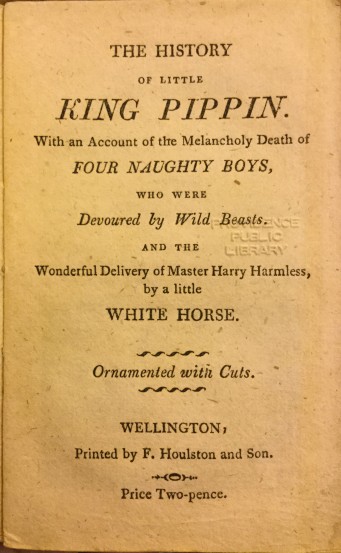
Melancholy! Intrigue! Danger! A little white horse! This wee book is undated, but was probably printed around 1820.
As the saga unfolds, the reader is introduced to good children with names like Kitty Kindness, Billy Meanwell, Sammy Sober, Bobby Bright, and Tommy Telltruth. (King Pippin himself is actually Peter Pippin, the King of the Good Boys.) YAWN.
The tension builds as we meet a gaggle of ne’er-do-wells with equally alliterative and terrible names such as Harry Harmless, George Graceless, and Tom Tiger.
It’s clear that trouble is brewing when the bell rings to return to school, the Good Boys race to see who can get to the schoolhouse first, and the Wicked Boys stroll into the woods with the express purpose of destroying birds’ nests.
After tearing down innumerable nests, including that of a robin who was left “making such piteous moans, as would have melted a heart of stone”, George Graceless scales a “great high tree” to reach the nest of a turtle dove. What happens to a wicked boy who climbs a great high tree?
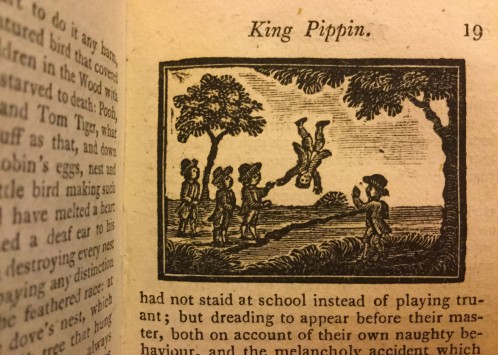
You guessed it! He plunges head-first into a narrow but apparently very deep river while one friend reaches out a tentative finger and another takes a picture with his iPhone!
Oh save me, save me, I shall be drowned; oh, that I had attended to the good advice of Little King Pippin, cried he, and with these words, down he went to the bottom, and was never seen more; the rest of his companions began now to see the folly and wickedness of neglecting their books for idle mischief; and heartily repented that they had not staid at school instead of playing truant.
Now, I don’t know about you, but when I heartily repent, I usually head back out of the woods, but this questionable quartet is filled with dread and decides to “stroll about” until it becomes “quite dark”. (Cue scary violin music!)
They fall asleep under some bushes, which seems like a good idea, until:
in less than an hour, they were awakened with such terrible howlings of wild beasts as was scarce ever heard, tigers, wolves, and lions, hunting for their prey, with eyes that glared like balls of fire, rushed by them every instant.
Amidst this impressive biodiversity, Harry Harmless falls to his knees to pray, whilst his companions, who have never even bothered to learn any prayers, are quickly devoured by two monstrous lions.
Not that the title gave it away or anything, but the next morning, a pretty little white horse awakes Harry Harmless with her neighs. He climbs into her mysteriously unpopulated saddle and is promptly delivered to his home.
The Ebon Box. Emily Dickinson, n. 169 (1860)
In Ebon Box, when years have flown To reverently peer – Wiping away the velvet dust Summers have sprinkled there! To hold a letter to the light – Grown Tawny now, with time – To con the faded syllables That … Continua a leggere
Magician of the Week #44: Brian Mainwaring
It’s Tuesday, so we’re currently having open hours, featuring some beautiful floral pochoir prints by Edouard Benedictus and the classic Flowers in Nature and Design by Fritzi Brod. (The latter features layered transparencies showing the color separations for various floral motifs.)
For those of you who can’t make it over in person, we also have a virtual featured magician from our Percival Collection: Brian Mainwaring, “The Gentleman From London.”
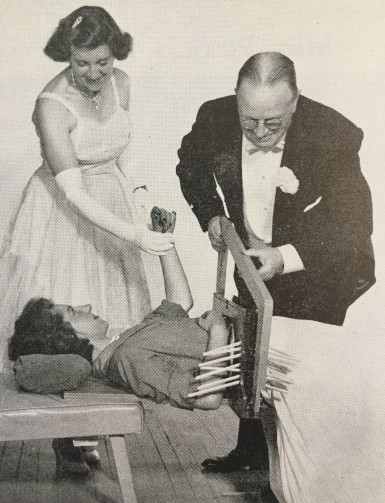
Here’s Mainwaring gleefully sawing a woman in half while his lovely assistant takes said woman’s pulse. (Isn’t it always reassuring to get medical support from someone in opera-length gloves? They just look so… chic yet authoritative.) The image above is from the souvenir program of the Twentieth Annual New England Convention of Magicians, held in 1958 in New Haven, Connecticut.
Mainwaring was born outside of London, attended Naval Military School, and spent time living in India. After marrying Christine Sanders, he settled in Bridgeport, Connecticut. He doesn’t seem to have left much of a paper trail, although I did find him listed as entertainment in a fantastic newspaper article with the headline “5 Santas to Greet Trumbull Kids”. Five santas! How extravagant!
Summer Report
A look at what a student worker has been up to in Special Collections & Archives this summer
My name is Meg Barrett and I started working with Special Collections and Archives at the beginning of the summer. When I found out that I was going to be working on digitally archiving old pictures from the College of Nursing and the French Napoleonic newspaper Le Moniteur, I was ecstatic. I’m currently a sophomore, majoring in Art History and minoring in French, so old photographs and French newspapers are exactly the sort of things that I love.
Because I am working on two different projects, I generally spend the first half of the week in the Research Center Reading Room and the second half in the Digital Library Center (DLC). In the reading room, I go through and catalogue the volumes of Le Moniteur. On my first day, I started with papers from the year 1792, and I finished the summer with papers from the year 1800. I think it’s amazing to be able to say that I’ve gone through over 2,000 newspapers from the 18th century! In the DLC, I have boxes of photographs in file folders, and my job is to scan the pictures onto the computer, type up information about them into a metadata spreadsheet, and then upload them onto DigiNole so that people anywhere can access them. The dates of the photos range from the 1950s to today, and seeing things from pinning ceremony traditions and headshot styles transition from then to now is such an interesting thing.

Working in Special Collections has been such a wonderful experience: what I’ve been doing has been interesting, the people have been so kind and helpful, and I enjoy it every day. When I found out that I got the job a few months ago, I couldn’t believe it. It’s now the end of the summer, and I will continue working on these projects, and I still can’t believe it!
The Social Dorms
As the social dorms have just been torn down this summer, replaced for the moment by a giant construction site, let’s take a moment to look back at their beginnings. The five social dorms (Pond, Coolidge, Crossett, Davis, and Stone) were built as part of a $17 million development plan (the Amherst Capital Program) which included building Frost Library and the Valentine Annex, among other projects. Construction began in 1962, they began housing students in 1963, and the last of the dorms were completed by 1964.Construction was not without hiccups- several dorms were without hot water for the first months of school when they opened in September of 1963, and the entire complex was without heat for two months.

1962 groundbreaking (site of Davis dorm) with Plimpton, McCloy, and Knight

1962 dorm construction

A 1962 visit by Trustees’ spouses, in front of Crossett

A view of the completed social dorms
The social dorms were built to alleviate overcrowding in Amherst’s housing- to accommodate more students from the growing student body, and provide more comfortable, private, effective accommodations. A 1930s faculty committee tasked with a study of the student environment stated that:
“Without discounting matters of age, individual variation, maturity, or custom, it does not seem unreasonable to associate much of the immature irresponsible behavior of some of our students with the physical conditions under which they live. Crowded, impersonal, barracks-like accommodations are too apt to invite a lack of respect both for those surroundings and for their other inhabitants… To be housed like a schoolboy or a recruit is for many to behave like one.”
The creation of the new dorms, which were organized around a suite-style model, with singles clustered around a common room and bathroom, were intended to address such criticism and provide space for students to not just sleep, but also work, as school work was increasingly carried out in student rooms instead of the library. The dorms were quite popular with students at the outset, and their layout and design were widely praised. They were seen as largely quieter than the fraternities during the 70s and early 80s, but with the abolition of fraternities in 1984, they began to become more a center of student activity and partying.

Coolidge interior

1960s Crossett interior
The dorms were named for a variety of Amherst graduates. Coolidge Hall was (obviously) named after President Calvin Coolidge (AC 1895); Stone was named after Chief Justice Harlan F. Stone (AC 1894). Davis Hall was named after Arthur Vining Davis (AC 1888), former chairman of the board of the Aluminum Company of America, who gave funds for the dormitory’s construction. Crossett was named after Edward C. Crossett (AC 1905), a long-time beneficiary of the college. Pond is the namesake of Peter Pond, an 18th century fur trader, soldier, and explorer who once served under Lord Jeffery Amherst and was an ancestor of the anonymous donor for the dorm.
Getting Our House in Order: Creating a Diverse and Inclusive Workplace
Yesterday, I had the privilege to speak to my colleagues in the archival profession at the Joint Annual Meeting of the Council of State Archivists and the Society for American Archivists in Atlanta, Georgia, about an important topic to me and an ongoing focus for us at the National Archives: diversity and inclusion.
In my remarks, I said:
I’m pleased to be able to join you this morning and especially pleased to have been slotted just before Chris Taylor takes the stage because it gives me an opportunity to talk about Diversity and Inclusion from my perspective. I was also inspired by Dennis Meissner’s column on “Building an Inclusive Profession” in the Spring issue of Archival Outlook in which he reminds us that “We remain too white, too traditional, perhaps too blind to the varieties of diversity that surround us.”
One of the joys of heading an Executive Branch Agency in the Federal Government is the what sometimes seems daily delivery of White House Executive Orders or Directives or Initiatives. For me each one presents more than just a compliance mandate, each one provides what I call an insinuation opportunity—is there a way to insinuate the National Archives and our work into the new venture. And, better still, where can we provide some leadership to the rest of the Federal Government. So, I remember when in the Summer of 2011, Executive Order 13583 hit my desk. “Establishing a Coordinated Government-wide Initiative to Promote Diversity and Inclusion.”
I think anyone who has worked with me over the years can testify to my commitment to creating a diverse and inclusive work environment—from my early days at MIT working with the Cambridge Public Schools to introduce kids to careers in libraries and the appointment of our first community outreach librarian; at Duke winning the President’s first Diversity Award for our work with the Office of Institutional Equity; and at the New York Public Library with the most diverse clientele of any public library in the world, ensuring that our staff of 2500 was as diverse as our user profile.
President Obama’s Executive Order spells out the Administration’s commitment: “Our National derives strength from the diversity of its population and from its commitment to equal opportunity for all. We are at our best when we draw on the talents of all parts of our society, and our greatest accomplishments are achieved when diverse perspectives are brought to bear to overcome our greatest challenges.”
The Order was followed 120 days later with the “Government-Wide Diversity and Inclusion Strategic Plan” challenging each agency to RECRUIT from a diverse, qualified group of potential applicants to secure a high-performing workforce drawn from all segments of American society; CULTIVATE a culture that encourages individuals to contribute to their full potential and further retention; and DEVELOP structures and strategies to equip leaders with the ability to manage diversity, be accountable, measure results, refine approaches on the basis of such date, and institutionalize a culture of inclusion.
At the National Archives, this mandate is reflected in Goal Four of our most current Strategic Plan: “Build Our Future Through Our Staff” where we commit to implementing innovative practices and tools to recruit, sustain, and retain a 21st Century workforce. So let me tell you how we are turning those promises into action.
Our Office of Equal Employment Opportunity is responsible for the management of our Diversity and Inclusion Program—the proactive side of EEO providing a number of services and educational opportunities for all employees in an effort to attract, sustain, and retain a diverse highly qualified workforce from the nation’s best and brightest talent available. Through this program, employees are encouraged to promote and support an inclusive culture that embraces the Agency’s values of collaboration, innovation, and learning. We strive to foster a work environment that recognizes individuals for their unique perspectives and experiences, establishing a culture where all employees are included and are able to contribute to their full potential.
The Diversity and Inclusion Program has three components:
The Affirmative Employment Program (AEP) created to assist the Agency in establishing and maintaining a model EEO program to ensure that our workforce is representative of the Nation we serve. This is accomplished through the AEP initiatives—The Special Emphasis Program and the Disability Program.
The Special Emphasis Program (a Federal Government wide program) was launched at NARA in November 2013 to assist in identifying gaps and providing recommendations to management officials and employees on matters the affect equal employment opportunities in the workplace. And who better to work as change agents than the employees themselves? We now have 57 volunteer Special Emphasis Program Managers throughout the agency in 15 states ranging from grade level GS3 to GS14. These folks are a resource to managers and supervisors, employees, and prospective applicants throughout the employment cycle—outreach, recruitment, hiring, employee development and advancement, and retention. The assist in the evaluation of policies, procedures, and practices as well as in the elimination of potential or existing barriers.
An integral component of the Affirmative Employment Program is our Disability Program which handles reasonable accommodation requests; collects and analyzes data to assist in the recruitment, hiring, and advancement of persons with disabilities; provides training and educational awareness for managers and supervisors; and manages our Agency-wide American Sign Language program.
The second component of our D and I Program is Targeted Outreach and Recruitment which partners with our Human Resources personnel to provide consultation services to hiring managers in an effort to hire qualified diverse candidates; and manages our Summer Diversity Internship Program. This year 11 qualified interns worked with nine NARA program offices.
And the last D and I component is our suite of Workplace Culture Programs. One is our D and I Education Program which focuses on educating agency leaders and employees about inclusive behaviors that impact employee engagement. It offers a comprehensive approach to cultivating a diverse workforce as well as fostering and sustaining a more innovative, inclusive, and respectful workplace. It also provides a wide range of tools to help increase the behaviors during day-to-day engagement—training using a variety of delivery methods focusing on awareness, attitudes and behaviors, knowledge and skill, and policy and practice. Some of the most important training deals with dignity and respect in the workplace; stereotypes and bias; fostering a diverse and inclusive workplace; hiring and interviewing through a diverse and inclusive lens; and other soft skills training in support of employee engagement.
Lastly our newest effort is the creation of Employee Affinity Groups. These are self-forming NARA communities of interest who raise cultural awareness, enable collaboration and knowledge, share, and promote personal growth. Remember, that we are an agency of 3000 spread across the country, so the opportunity to develop community this way is especially important to our goal of creating One NARA. Launched in 2015, we now have six Employee Affinity Groups.
Stonewall—serving the LGBTQ community
IKE—serving our veteran community
Hispanic and Latino Organization (HALO)
disABILITY—serving our disabled community
Women’s Affinity Group (WAG)—serving NARA women
Say It Loud!—serving our African-American community
As you can see, we employ a wide variety of approaches and opportunities in an effort to create a culture which embraces diversity and inclusion. We are making a commitment from the top of the Agency to ensure that this is core to who we are and how we do business. Are we there yet? No. But I am confident that together we can create a more inclusive work for NARA and for the Federal Government.
![]()
The Battle of the Slums Revisited
The Battle of the Slums Revisited, is how this 1950 edition of the Cooper Union Forum might be titled. Fifty years after Jacob Riis’s famous speech on the subject at the Great Hall, his son, Roger William Riis, addresses the same issue, tenement conditions and the need for affordable housing. Alas, the younger Riis is not the firebrand his father was. In measured if not stultifying tones, the reporter and roving editor for Reader’s Digest presents an array of both historical and modern-day “dragons” standing in the way of housing reform. The historical ones include greed, indifference, race discrimination, etc. He paints a sad if familiar picture of turn-of-century tenements. The practical test police used to see if a hallway was ill-lit was if you saw a baby playing in the hallway there was sufficiently illumination; if you stepped on the baby first, there was not. As early as 1889 statistical evidence showed poor blacks were being charged higher rents than poor whites. Turning to the current situation, Riis lists six new dragons, although some seem to have survived the intervening fifty years quite comfortably, greed and race discrimination among them. The cost of land has now become a factor, however, and “the microscopic minds of bankers.”
Riis’s argument is two-fold: he sings the virtues of public housing, comparing them to well-run businesses that, contrary to public opinion, bring more money to the government than they cost to maintain. At the same time he argues strenuously against the equally common misconception that housing for the working poor is unprofitable and therefore of no interest to the private sector. In particular, he argues that the presence of blacks does not economically depress a neighborhood. Rather, when a neighborhood is already on the downslide, slumlords increasingly rent to blacks. Marshaling a numbing array of statistics, Riis attempts to show that today’s bankers and entrenched real estate interests make a tidy profit on the poor, mainly by charging disproportionate rents and providing almost no services in return. His description of absentee landlords and the myriad of shell corporations employed to protect owners is depressingly familiar.
The question and answer period that follows is an interesting glimpse of mid-century political rhetoric. The meeting seems “packed” with socialists and communists who, one after the other, rise and give obviously prepared soapbox speeches against private ownership of property and free enterprise. Riis refuses to take the bait, however, defending the current system, once again making newly-built public housing sound like Shangri-La, and putting his faith in General Thomas Farrell, at that time head of the New York City Housing Authority. The recording breaks off in the middle of the Q&A.
Riis had no way of knowing that he did his research during the short-lived Golden Age of public housing. Following the end of World War II, the housing market was flooded by returning veterans and, soon after, their young families. This pressure led to the construction of vast developments of publically-owned units. Then, at some point in the mid-fifties, for reasons that are still hotly debated, a mass exodus of these same families either caused or was precipitated by a change in the population of public housing. The slow decline began in which the poor and minorities were in effect “warehoused” in increasingly substandard and badly-maintained dwellings. While Riis’s indignation at the way the poor are housed remains as fresh-sounding today as it did then, his championing of the government as landlord now sounds more than a little suspect.
Jacob Riis (1849-1914) came to America as a penniless immigrant from Denmark. His reaction to the poverty he found here turned him into one of the first and most prominent social activists. Rather than simply plead for charity to be delivered from on high, he forcefully stated his case that the poor deserved basic elements of human comfort such as clean air, sufficient light, and drinkable water. He seized upon technological improvements in photography as a way to further his aims. As Jimmy Stamp, writing for smithsonian.com noted:
The recent invention of flash photography made it possible to document the dark, over-crowded tenements, grim saloons and dangerous slums. Riis’s pioneering use of flash photography brought to light even the darkest parts of the city. Used in articles, books, and lectures, his striking compositions became powerful tools for social reform.
Jacob Riis strikes one today as a curiously “modern” figure, with his “slum tours” for the concerned well-to-do, and his expert playing of the media. Disturbingly, one could argue that not much has changed in the city he is most associated with. As NPR commentator Robert Siegel puts it:
Poverty struck Riis as abnormal — even for the various immigrant groups whom he regarded as exotic. When he lived in New York City, about 40 percent of the population was foreign-born. It’s just about the same share today.
Audio courtesy of the NYC Municipal Archives WNYC Collection.
WNYC archives id: 150177
Municipal archives id: LT1349
PIDB Public Meeting Recording Now Available
The PIDB hosted a public meeting on Thursday, June 23, 2016 at the National Archives. The meeting was an opportunity to engage publicly with White House leadership on progress in developing a technology investment strategy for the management of classified information. The meeting was also a chance to hear comments from current and former members of the PIDB and have a dialog with civil society groups, government stakeholders and the public on the work of the PIDB. You may view the meeting here and its transcript here.
Mr. John Fitzpatrick, Senior Director for Records Access and Information Security Management at the National Security Council, provided a summary of the progress he is making to instigate White House commitment to improving declassification through the use of technology. Mr. Fitzpatrick provided an update on the collaborative work of the Classification Reform Committee and the Office of Science and Technology Policy to build a cross-agency program leveraging technology and altering long-standing policy and practice. This is a challenge never before addressed at this level of government. Mr. Fitzpatrick indicated the expressed interest of the President has incentivized the Executive Branch to complete the framework for the technology investment strategy in order to ensure the long-term sustainability of a new program in the years ahead.
The impetus for White House-level commitment in building a technology strategy stemmed from previous recommendations made by the PIDB. The members have recommended in all of their previously published reports the need for the government to seriously commit to improved technology for the specific purpose of modernizing classification, declassification and records management. In an effort to expand on these ideas, the PIDB published its newest white paper, The Importance of Technology in Classification and Declassification. The white paper describes the work of the PIDB to study in-depth agency declassification technology initiatives. It summarizes findings made by the PIDB’s Declassification Technology Working Group to understand how ready agencies are for managing classified information in the digital age and what challenges, barriers and opportunities exist for modernization across the government. The narrative also makes more specific recommendations on next steps and addresses the needs of agencies, including the requirement of more resources to fund technology investment for these programs.
The public meeting was also an opportunity for the public to hear from the members. Nancy Soderberg, the PIDB’s outgoing Chair, had an opportunity to provide observations from her time on the PIDB, including giving candid commentary on the need for immediate action by the White House to provide resources and solidify a policy and strategy for improved technology investment for classification, declassification and records management. The PIDB’s Acting Chair, William Leary, also announced the impending appointments of new members James E. Baker and Trevor W. Morrison (who will also be the PIDB’s new chair).
The PIDB will continue its engagement with civil society groups and the public in the coming months as it begins discussing what policy recommendations it will make to the incoming Administration concerning transformation. Please continue to remain engage with the work of the PIDB through its blog and website.
![]()
Information Security Oversight Office Releases its Annual Report to the President
Today, our Information Security Oversight Office (ISOO) released online its Report to the President for Fiscal Year (FY) 2015. This annual report covers government agencies’ security classification activities, shares cost estimates for these activities, and provides an update on the Controlled Unclassified Information (CUI) program. This annual report was mandated by Executive Order 13526, Classified National Security Information.
Declassification highlights from this FY 2015 report include:
- A 14 percent increase in original classification activity, for a 2015 total of 53,425 decisions.
- A 32 percent decrease in derivative classification action, down to 52,778,354 decisions.
- Under automatic, systematic, and discretionary declassification review, agencies reviewed 87,192,858 pages and declassified 36,779,589 pages of historically valuable records. This was a 35 percent increase in the number of pages reviewed and 32 percent increase in the number of pages declassified.
- Agencies reviewed 391,103 pages under mandatory declassification review and declassified 240,717 pages in their entirety, declassified 109,349 pages in part, and retained classification of 41,037 pages in their entirety.
Classification:
ISOO continues to monitor agencies’ self-assessments of their classified information programs. While many agency reports show improvement, others are lacking. ISOO will continue to help agencies with these assessments to ensure compliance.
Controlled Unclassified Information program:
- ISOO continued to advance its policy development strategy, as its submitted proposed Federal CUI rule (the future 32 Code of Federal Regulations part 2002) underwent extensive agency and, after its publication in the Federal Register, public comment.
- ISOO continued its CUI Program appraisal process to assist executive branch agencies in preparing for implementation by providing agency planners with a baseline.
- ISOO also coordinated a timeline for phased implementation of the CUI Program for the executive branch, which will be provided to agencies at the time of the regulation’s issuance.
Industrial Security:
- The National Industrial Security Program Policy Advisory Committee (NISPPAC) developed procedures for implementing an insider threat program, and continued to advance the government-industry partnership.
- ISOO contributed significant support to the administration’s cyber security information sharing initiatives, guiding NISP partner agencies through the creation of novel risk management processes made effective as part of E. O. 13691 “Promoting Private Sector Cyber Security Information Sharing.”
- The NISPPAC also focused on the challenges concerning the personnel security clearance vetting process and the methodology for authorizing information systems to process, store and transmit classified information.
The Information Security Oversight Office, established in 1978, is responsible to the President for overseeing the Government-wide security classification program, and receives policy and program guidance from the National Security Council. ISOO has been part of the National Archives and Records Administration since 1995.
I am very proud of the work of our ISOO staff in ensuring that the Government protects and provides proper access to information to advance the national and public interest.
![]()
Happy Birthday, Beatrix Potter!

July 28, 2016 marks the 150th anniversary of the birth of Helen Beatrix Potter in Kensington, London. Beatrix Potter (1866-1943) is best known as the author and illustrator of children’s classics like The Tale of Peter Rabbit and The Tale of Benjamin Bunny. These delightful stories, set in the English countryside, were originally drawn and written as greeting cards and letters to the children of Potter’s friends. Beginning in 1900, Potter started sending her stories to publishers, but after six rejected submissions, she published the books on her own. As part of the John MacKay Shaw Childhood in Poetry Collection, FSU Special Collections has one of the original Beatrix Potter books: The Tailor of Gloucester printed in London by Strangeways and Sons in 1902.

After the success of her self-published children’s books, Beatrix Potter was picked up by the publishing house Frederick Warne & Co, who had originally turned down her manuscripts. In addition to the first edition of The Tailor of Gloucester, FSU Special Collections has over 100 works by Beatrix Potter in our rare book collections. The Gwen P. and Allan C. Reichert Beatrix Potter Collection contains biographies of Beatrix Potter and several editions of The Peter Rabbit stories, as well as adaptation pop-up books, cookbooks, coloring books, and more. A corresponding archival collection with Beatrix Potter related toys and ephemera will also soon be available to researchers.
Robert Moses’ Ten Commandments
Neither Moses nor Yahweh chose to elaborate at length on the Ten Commandments, leaving that impossible errand instead to the prophets, politicians, and hoi polloi of the millennia that followed. Perhaps His authority was thought to suffice. In this recording, the other Moses—Robert Moses, the seemingly but briefly omnipotent commissioner-of-everything New York—offers the graduates of New York Law School his own “decalogue,” his ten commandments, with a pointed defense for each, aimed to guide the young barristers as they begin their careers in his New York City. You could almost call it sacrilegious, but then Moses was never a particularly religious man.
Though Moses declares that he is “no Polonius offering a pompous, condescending philosophy to youth,” he doth protest too much; in this speech at least, he pretty much does exactly that. Here are his first nine commandments, in his words:
- Have pride in your city
- Be suspicious of lurid criticism, baseless disclosures, and easy remedies
- There are no easy fixes
- Belong to a party, but don’t be a violent partisan
- In government, view every dogma with skepticism
- Never fear to be in a minority
- Beware of dogmas about equality
- Beware of extraneous issues, appeals to race, creed, color, and residence
- Try your best to guard against appeals to bias and prejudice in whatever form, ancient grudges, bygone feuds, and what the poet called “old unhappy far off things and battles long ago.”
At turns shruggingly true, trite, vague, debatable, and/or false, and as a whole, repetitive and often contradictory. However, no more trite-and-true these days than the original Ten, which we’ve now had centuries to internalize. It’s when he elaborates on these that the true purpose of his commandments is revealed: this decalogue is yet another broadside attack on the growing mass of men and women finding fault not just in his methods, but in his very philosophy of city making—a defensive attack from a wronged man on his multitude of benighted “critics.” In this too he has company; Yahweh could be pretty defensive as well.
He spends the bulk of his speech on his tenth commandment—on the importance of the proper use of language—though it is difficult to distill his wisdom from his words:
10. “Finally, something about speaking and writing our native language…”
It reads less like a commandment than a placeholder inserted into an early draft, some lorem ipsum meant to be rewritten as some pithy yadda yadda he never got around to committing to script. It would be wrong to accuse a man as industrious as Moses of being lazy, but, well, he had his priorities.
Make what you will of his writing advice, but we’ve listened to dozens of Moses’ speeches here at the WNYC archives, and researched quite a few of his writings, arguably enough to give us some insight into how he approached the craft in practice. Distilled to its essence, Moses’ approach to writing consists largely of inserting as many allusions to classic literature and letters as possible—directed at the narrow contingent in whatever audience that might “get” them—into verbose, combative prose shot with broad aim at anyone who dare criticize his vision. The allusions? Blink and you’ll miss them. And if they don’t scan? So be it. For Moses, your philistinism would render you unworthy of judging men of his brilliance. It’s best you step aside and let the man do his work. In practice, it can tend toward tedium, and the relentless stacking of obscure allusions to the peril of quality prose is a common habit in those who take pride in their erudition, one that he frequently shares (I am often guilty myself). But I think he has a recognizable talent for it, and more often than not his approach falls on the right side of listenable. It’s almost fun.
“Pile Pelion on Ossa”
We made an earlier web piece exhaustively annotating one of his speeches, so we won’t do it again here (FYI – the poet in commandment nine is Wordsworth). But I would like to comment on one allusion that sent me into a frenzied evening of thumb-heavy research: “Pile Pelion on Ossa.” It is an idiom, not currently quick to the tongue, that refers to a tale from Greek mythology. In that myth, the Aloadae—Greek giants Otus and Ephialtes—attempted to storm the stronghold of the Gods by piling Mount Pelion and Mount Ossa atop Mount Olympus. They failed. According to the OED, it means “Add a difficulty or task to something that is already difficult or onerous.” I’m not sure that Moses’ usage of phrase is perfectly captured in that definition, but I’ll defer to Moses’ superior education; perhaps there is something in the tale that is apropos to the day’s commencement missing to the passive listener, other than doubling down on the mountain imagery of Moses’ commandments. As much as the idiom is not in common use, its literary pedigree is unassailable. The curious may reference Homer (Odyssey, Book 11) and Hamlet (Act V, Scene 1), Virgil (Georgics, Book 1) and Ovid (Metamorphoses, Book 1), and doubtless countless others.
I’m not sure how or when it became an idiom, but it did, eventually settling into “Pile Pelion on Ossa.” Those who have listened to the audio above will have noted that Moses reverses the order, piling “Ossa on Pelion.” This is not a mistake, not quite. Homer, likely prioritizing poetic form above the strict rendering of myth, seems to have reversed the logical order, and its his version that is followed in the surviving phrase, which Moses, following Virgil, corrects. As Classicist Philip R. Hardie recounts:
“Virgil, doubtless attentive to the fact that the Homeric text had two lines earlier specified Olympus as the object of these monsters, questioned the reasoning of ending up with Olympus at the bottom of the heap and gave us the present lines: thrice they tried to put Ossa on Pelion and Pelion to roll on leafy Olympus – in other words he reversed the Homeric order.”
Alexander Pope had this to say about the literary gifts of Homer and Virgil: “Homer scatters with a generous profusion, Virgil bestows with a careful magnificence.” He actually had a lot more to say about the two, and I could readily be accused of cherry picking this particular sentence to belabor a point, but I feel there is something telling in Moses’ preference for Virgil here, something revealed in just those lines. Moses’ public works and words almost always display a “careful magnificence”: the highways and structures, and essays and speeches he is responsible for having created are nothing if not grand, letter-perfect hymns to his vision and his estimable ethic and knowledge. But they lack the generous profusion, the beauty of the human scale, that makes literature sing and cities beam with life.
His city and his speeches are meticulous and stiffly elegant, and often ambitious and imaginative, but they are unloved and unloving. They exist to be scanned on paper, as blueprints and scripts, where they can achieve their own dubious and cold perfection, rather than to be lived-in and heard, where we can achieve ours.
Audio courtesy of the NYC Municipal Archives WNYC Collection.
WNYC archives id: 150454
Municipal archives id: T9278
Records Management Self-Assessment
I am pleased to announce that the 2015 Records Management-Self Assessment (RMSA) report is now available.
Laurence Brewer, Chief Records Officer for the U.S. Government, said, “This is our seventh RMSA, and we are very pleased to see real progress being made by agencies. We expect this improvement to continue, especially as agencies continue to work towards achieving the goals in the Managing Government Records Directive.”
Some highlights from the 2015 data include:
- There continues to be gradual improvement in overall scores.
- RMSA findings and recommendations are consistent with the goals and requirements of the Managing Government Records Directive (OMB M-12-18). We believe improvement will continue as the requirements of M-12-18 are implemented and as our records management oversight activities persist.
- The majority of agencies indicated their records management staff have oversight over records created at the highest levels of their agency (i.e., those of the agency head and appropriate advisors and executive staff).
- Agencies have policies and procedures in place for email. However, there is little or no auditing for compliance.
- A majority of agencies are planning to implement the Capstone approach for managing their email.
- Fewer than half of agencies report having records management staff participating in the design, development, and implementation of new electronic information systems. Of those who participate, only a quarter have approval authority.

Surveying the records management landscape across the Federal Government.
“Building Survey,” National Archives Identifier 32200321
We use this annual self-assessment to determine whether Federal agencies are compliant with statutory and regulatory records management requirements as well as to identify trends and areas where further guidance may be necessary.
Federal agencies use the annual self-assessment to identify strong and weak areas of their records management programs and to determine the impact of changes they have made since the previous self-assessment.
As a whole, the data in this report is used to improve records management practices within the Federal Government. Records management is the backbone of open government; effective records management by all Federal agencies ensures the preservation and access of the permanently valuable records of the Federal Government.
If you have any questions regarding the RMSA, please feel free to leave a comment here on the blog or send an email to rmselfassessment@nara.gov.
![]()
Happy Casey Stengel Day!
Casey Stengel’s birthday is celebrated in New York, although the date (July 22, 1965) is not, in fact, Stengel’s birthday, as he is quick to note. Indeed the manager of the hapless Mets is quick to note everything in this amusing “raw” tape from a stage-managed publicity event. Stengel and reporters are waiting for the arrival of Mayor Wagner, who will present the (still) 74-year-old manager with a proclamation in honor of his 75th birthday. (Presumably Stengel will be on the road then.) While they wait, reporters banter with Stengel, who launches into his patented stream-of-consciousness responses, listing all of fellow-player Babe Herman’s children’s careers, opining that Mickey Mantle is “an amazing man for a cripple,” and promising one reporter “if they have cake I’ll cut you a nice big piece of it.” The only serious note is Stengel’s future with the Mets, who are enduring another awful season. It’s clear he is going to retire but has been told not to announce the news yet. He tries explaining that he has been “building for the future,” which is why the current team struggles. He reminisces about his playing days, decides on the greatest pitchers he faced (Walter Johnson in the American League, Grover Alexander in the National), all while displaying the crafty mix of street-savvy and seeming buffoonery that made him a fan favorite over the years. Eventually, the mayor arrives and there is a brief ceremony with much posing for photos. In the midst of the raillery he is asked again, “Is this your last year?” Turning serious for a moment, he answers, “It should be,” before going on to praise the young Ed Kranepool and Ron Swoboda. The tape ends as it began, with the milling murmuring of reporters, and Stengel gamely entertaining anyone willing to listen.
Casey Stengel was born in 1890. A fine player, his skills were often overshadowed by his on- and off-the-field antics. One of his most famous stunts occurred in 1918 when he returned to Ebbets Field after having been traded to Pittsburgh. As the New York Times describes:
Catcalls cascaded down from the stands. His reputation as a prankster and a clown already established, Stengel that day marched to home plate as the hooting intensified, bowed with courtliness to the fans in the grandstand, and doffed his cap. Out flew a sparrow. He had given them the bird.
After fourteen years in the majors, Stengel managed a variety of clubs, none very successfully, until his amazing run with the Yankees during which he won seven World Series. His time with the Mets was more famous for the team’s inept play and the manager’s “Stengel-isms,” although one could argue, as he does here, the foundation was being laid for the eventual world champion team of 1969. More importantly, Stengel’s “Old Perfesser” persona endeared the new team to the city. Sportswriter Robert Lipsyte, describes watching Stengel during the 1962 spring training:
He could also be incredibly kind, particularly sensitive to the disabled. He would unselfconsciously offer up his seamed face to the questioning fingers of blind fans and trot up the grandstand on his bandy legs to patiently chat with people in wheelchairs. Once, while I was talking to Stengel, a middle-aged man approached, dragging a sullen teenager. This was clearly a troubled son and dad. The man claimed to have played for Stengel years ago in the minors. Stengel took his time, regaled them with tales of the father’s prowess and promised the kid a Mets contract if he got as good as his old man. As they left with arms around each other, Stengel rolled his eyes at me and shrugged. He had no memory of the man.
As a manager, Stengel is credited with regularizing the practice of platooning players. He had difficult relationships with his teams, particularly the Yankee squads. As Bill Bishop, writing for SABR (the Society for American Baseball Research) reports:
Casey’s explanation for his managerial success was, “Keep the five guys who hate you away from the five who are undecided.”
As for his bizarre way of answering questions, some of his musings have the quality of Zen koans, as evidenced by this well-known yet essentially unknowable remark:
“There comes a time in every man’s life, and I’ve had plenty of them.”
Stengel did retire in August of 1965. He lived long enough, though, to follow and, typically, name the “Amazin’ ” Met team of 1969.
Casey Stengel died in 1975.
Audio courtesy of the NYC Municipal Archives WNYC Collection.
WNYC archives id: 150005
Municipal archives id: T778
Electric Eels Bunking with Tigers: The Itinerant New York Aquarium
On October 1st, 1941 Castle Garden in Battery Park shut its doors as the New York Aquarium. It would take sixteen years for the aquarium to find a new home at Coney Island.
Operating under the aliases West Battery, Castle Garden and Castle Clinton over its 208 year life span, the building has served as a fort, grand ballroom, spa, gateway for millions of immigrants and, today, a national monument. Images of the Aquarium at Castle Garden show finely dressed patrons staring down into pools of water. The aquatic life quite literally jumps out of unusually small enclosures backed with white tile and little natural vegetation, contrary to modern aquatic exhibitions.
According to William Bridges in A Gathering of Animals: An unconventional history of the New York Zoological Society:
[A Humboldt penguin]…lived in one of the floor pools by day (when it was not hopping out and following its keepers around the building), and at night it was kept in an open pen on the gravel roof. It was the first of what was in later years to be a succession of sea birds—pelicans, cormorants, gulls and the like—that [Director] Dr. Townsend insisted on keeping in the floor pools even though they were (to put it mildly) untidy in their habits, given to making noisome messes, and generally unsuitable for exhibition in a closed and not too well-ventilated building.[1]
Tour of the New York Aquarium at Battery Park
In this tour of the aquarium at Battery Park, you can hear Peter and Wendy, two noisy Sea Lions at feeding time.[2] A pair of waggish WNYC reporters interview Curator Dr. Christopher W. Coates as he describes the building and its inhabitants such as a seven foot long giant grouper, an African Lungfish and the Octopus, “villain of all underwater moving pictures.”
However, the real villain of the Aquarium at Battery Park—at least in the eyes of sentimental New Yorkers—was Parks Commissioner Robert Moses who fought to have the building demolished to facilitate the construction of the Brooklyn-Battery Tunnel. The New York Zoological Society had been managing the aquarium since 1902 and lobbying for assistance from the city to construct a new building since 1911. Thus, the doors to the aquarium were closed with the promise of an entirely new building, and one that was, most importantly, not circular![3]
In a 1941 letter to the New York Times Robert Moses wrote, “…the Aquarium is an ugly wart on the main axis leading straight to the Statue of Liberty—a vista of which future New Yorkers someday will justly be proud.”[4] However, uproar from the public, historic societies, and civic leaders saved the building from demolition and “Castle Clinton” officially became a national monument in 1950.
Stymied by the financial effects of the Great Depression and foreign wars, the New York Aquarium did not re-open until 1957. So what happened to the roughly 10,000 residents at Castle Clinton?
With funding from the city, specimens captured locally were returned to the sea while others were sent to nearby aquariums. A collection of specimens that were rare, valuable and popular were sent to live at the lion house in the Bronx Zoo. A 1942 article in the New York Times describes, “The present collection includes some 2,500 specimens of 104 species. Brilliantly colored tropical fishes were retained from the former collection and are in ‘jewel box’ settings with more elaborate underwater planting and decoration than at the old Aquarium.”[5] This included an Electric Eel exhibition where:
…at intervals during the day a rubber gloved tankman stroked the eel until it discharged its five hundred volts thereby causing a series of neon pips to spell out ELECTRIC EEL, a loudspeaker to crackle with static, and wavy blue lines to flicker across the face of an oscilloscope.
…the exhibition electric eel was not quite so popular with the Lion House keepers. Its tank happened to be directly opposite the compartment occupied by Dacca, the Zoo’s prolific tiger mother. (She had thirty-two cubs between 1948 and 1959.) During several of her pregnancies she took a fierce dislike to the eel, watching it intently and clawing at the wire front of her cage when it rose to the surface to take a gulp of air. For the sake of Dacca’s peace of mind, the eel tank was kept covered during the critical weeks.[6]
Coney Island was long considered the ideal site for the new aquarium, even before the doors were shut to the public at Castle Clinton. Mayor La Guardia saw an opportunity to spread cultural institutions to other boroughs and the site was adjacent to ocean water, yet also accessible to most New Yorkers and tourists. After a decade of planning and fundraising, the cornerstone was laid at Coney Island in 1954. By this time Coney Island had passed its halcyon days as the “Playground of the World” and was planned for residential rezoning.
New York Aquarium Cornerstone Laying Ceremonies
In this recording, Robert Moses posits the New York Aquarium as the symbol of a new family and tourist friendly Coney Island with an amusement section shrunk “to proper limits,” destined to overcome its sordid past:
Coney was town land owned by the people, given away to crooks for a song, and in a small part recaptured for the public at large expense. It had become, when we took it over under the new charter in 1937, a honky-tonk catch-penny waterfront. That only some 50 acres of receding over-crowded beach. It had a board walk with access underneath it from dubious, miscellaneous structures. Often at high tide there was no beach at all. Coney with its seasonal gaiety, in spite of its accessibility, under the auspices of absentee landlords, was on the way out.
The first stage of a grandiose 6.5 million dollar plan was completed by 1956. At the ribbon cutting ceremony, Fairfield Osborn, president of the New York Zoological Society predicted, “It is the beginning of an institution, which, if we can get the support, which we pray for, hope for and must have, will grow into the most incomparable institution of its kind anywhere in this country, or for that matter, anywhere in the world.” (Listen to the audio at the top of the article.)
The doors were officially opened when Annie, a black footed penguin, served as the ribbon cutter by biting at a wrapped smelt fish. A WNYC reporter described the melee as Annie performed her official duty and children poured past to explore the brand new, permanent home of the New York Aquarium.
____
Additional recordings:
1965 interview with Dr. Carl Ray, Curator at the New York Aquarium
He discusses the practicality of evolving man to live underwater as a solution to human over-population, “Now the physiological strain on man to do this is going to be solved, we are going to be able to go, there but how many people are going to be even willing to go there?”
Robert Moses speaking to the New York Zoological Society Annual Meeting in 1957
“One thing however we can agree on, that if once more, the long night descends upon the earth, setting us back thousands of years, when the luckiest reincarnationist will inhabit a pterodactyl immune to radioactive fallout, the most priceless evidences of the heroic ascent from clod to man, the hardest to duplicate and replace, will be those which are now exhibited in our great museums here in New York.”
____
[1] Bridges, William, Gathering of animals: An unconventional history of the New York Zoological Society, 1974, pg. 199
[2] This recording is incomplete and unidentified, but most likely an episode of All Around the Town. The audio has been edited for continuity.
[3] After taking over as Director of the Aquarium in 1902, Charles H. Townsend drew up several plans to improve Castle Garden for aquatic display and research, however the circular shape of the building proved too prohibitive, in his opinion, and he began lobbying for a new building.
Bridges, William, Gathering of animals: An unconventional history of the New York Zoological Society, 1974, pg. 192
[4] Moses, Robert, “Mr. Moses and the Aquarium: Tracing Somewhat Tarnish Past, He Insists It Be Banished From Battery”, Letters to The Times, New York Times, February 25th, 1941
[5] “Aquarium Will Open In New Home Today: Fish to Be Shown Among Murals in Lion House of Zoo,” New York Times, February 12th, 1942
[6] Bridges, William, Gathering of animals: An unconventional history of the New York Zoological Society, 1974, pg. 472-473
My special thanks to Madeleine Thompson, Archivist and Digital Resources Manager at the Wildlife Conservation Society. Check out Wild View: An Eye on Wildlife for more history on the Bronx Zoo and the New York Aquarium.
Audio courtesy of the NYC Municipal Archives WNYC Collection.
WNYC archives id: 150510
Municipal archives id: LT7646
FOIA Improvement and the FOIA Advisory Committee
On June 30, 2016, President Obama signed the bipartisan Freedom of Information Act (FOIA) Improvement Act of 2016 into law. This law locks into place many of the Administration’s FOIA policies and initiatives and solidifies the role of the National Archives’ Office of Government Information Services (OGIS) in resolving FOIA disputes between agencies and requesters and improving compliance with FOIA.
President Obama Signs S. 337 FOIA Improvement Act of 2016, June 30, 2016
The law:
- Codifies the Attorney General’s policy that agencies should release information unless “the agency reasonably foresees that disclosure would harm an interest protected by an exemption” or “disclosure is prohibited by law;”
- Requires that agencies alert requesters to the availability of agency FOIA Public Liaisons and OGIS to help resolve disputes at several points in the FOIA process;
- Directs the creation of a centralized portal the public can use to file FOIA requests electronically;
- Establishes a Chief FOIA Officers Council to develop recommendations for increasing compliance and efficiency in responding to FOIA requests, and to identify, develop and coordinate initiatives for increasing transparency and compliance with FOIA’s requirements;
- Requires that agencies post electronically records that have been requested three or more times;
- Requires that agencies allow a minimum of 90 days for requesters to file FOIA appeals; and
- Limits the deliberative process privilege to records that are less than 25 years old.
In conjunction with the bill signing, the White House also announced additional initiatives to continue to improve transparency. As part of this effort, the White House asked the members of the FOIA Advisory Committee to look broadly at the challenges that agency FOIA programs will face in light of an ever-increasing volume of electronic records, and chart a course for how FOIA should operate in the future.
The National Archives launched the FOIA Advisory Committee to allow agency FOIA professionals and requesters to collaboratively develop recommendations to improve the administration of FOIA. As I shared with you in April, the first term of the FOIA Advisory Committee ended on a high note when the Committee unanimously voted to support its first recommendation to improve the FOIA process. The Committee’s development of a consensus recommendation is an important milestone because it shows how agencies and requesters can work together to improve the FOIA process.
The second term of the FOIA Advisory Committee will kick off on July 21 with a meeting in the National Archives’ William G. McGowan Theater. Please visit the Committee’s webpage for information about future meetings and the Committee’s work.
We welcome Congress’s bipartisan, bicameral work to advance transparency, and the President’s new initiatives.
![]()
Magician of the Week #43: Carina Allston
This week’s magician, mentalist Carina (assisted by George Allston), is hailed as “bewildering!”, “amazing!”, “intriguing!”, and “new and different!”.
Here she is, blasting forth from somewhere in the midwestern U.S., all without losing her composure or the thing tossed artfully over her shoulder:
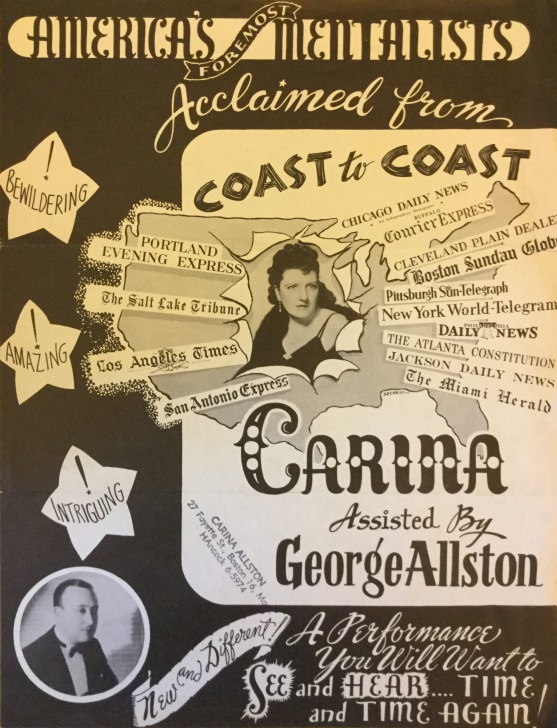
I really like that the newspaper nameplates/ mastheads are arranged roughly geographically.
This promotional flyer, from our John H. Percival Collection, indicates that the Allstons hailed from Boston, although I can’t find any further information about them online. Do you know more about Carina and her assistant? Let us know!
Bad Children of History #26: Naughty Newsboys
Our latest bad children of history, from Ned Nevins, the News-boy; or, Street Life in Boston (1867), have instigated a snow ball riot, pelting unfortunate adults before the police arrive to calm the fray.
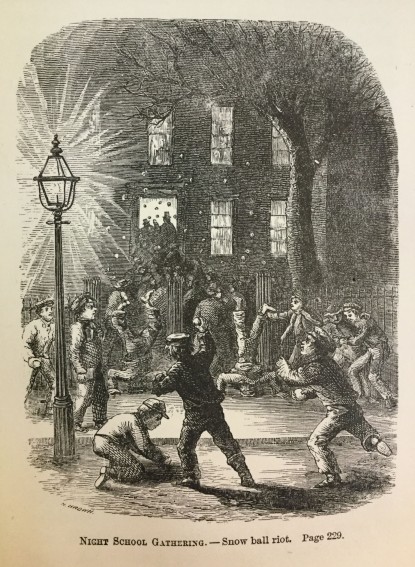
The accompanying text is terrific:
Now some ladies and gentlemen pass the crowd to enter the building; when, plump, plump, plump, the snowballs strike against the door before them, and dash into their faces. “Oh dear! they are killing me; I am all covered with snow; open the door, let me in; I shall die!” cries one lady, leading half a dozen others, who are muttering the same complaint. “Oh the rascals! they ought to be hung,” cries another: “they have spoiled my new bonnet.” Still another, “Oh dear! the snow is running down my neck. Oh! my bosom is full of snow.”
Lest one fear that author Henry Morgan, P.M.P. (Poor Man’s Preacher) reserved all of his contempt for the haughty upper classes, he immediately begins a (fictional-version-of-him)self-congratulatory screed about the problems of immigrants.
Rev. R. C. Waterston rose to speak. He started night schools in Boston, thirty years ago. What a change in thirty years! Whole streets and neighborhoods have given way to the foreign population; ancient land-marks are fast disappearing; Puritanism is becoming a thing of the past. America’s destiny rests on the tide-wave of foreign immigration: the problem of her future is involved in these boys. Now is the time to solve the question,–shall they overwhelm us? or shall we Americanize them?
Most of them are Catholics, averse to free schools and American ideas. Puritan principles are an offence unto them: their watchword is, “Papacy and Democracy.”
How… complicated. Who was this poor man’s preacher with such a deep commitment to immigrants and such a strong disdain for Catholicism?
Henry Morgan, according to my research, was a well-known preacher and social reformer. After the Methodist Church repeatedly refused to approve him for ordination, he moved to Boston in 1859, where he created his own denomination and began preaching in the Boston Music Hall. Morgan was soon drawing crowds with his powerful and theatrical oration. By May of that year, he had founded the Boston Union Mission Society in the South End, offering night classes to newsboys who couldn’t attend school during the day.
Based on his experiences preaching to and teaching Boston’s working immigrants, Morgan wrote Ned Nevins, the News Boy: or, Street Life in Boston in 1867. The book was so popular that it went through four editions in the months after its first publication. (You can find a scathingly sarcastic review, including such gems as “There is no ignorance in Boston. Everybody knows something about everything, there are a good many who know everything about something, and a few of the very first chop who know everything about everything” in The Round Table no. 140 from September 28, 1867. It’s truly superb. “We are puzzled to conceive how one would go about flattering a Bostonian.”)
You can read more about Henry Morgan in Benjamin Hartley’s book Evangelicals at a Crossroads: Revivalism and Social Reform in Boston, 1860-1910.
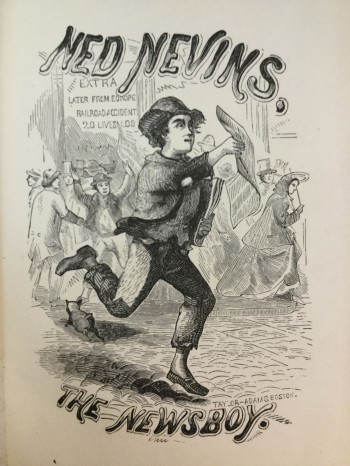
If you’re stumped for a topic for an academic paper, may I suggest a critical analysis of the post-snowball-riot chapter in this book entitled “Creatures in the Coal-Dump”? In this chapter, Ned goes coal-picking at the dump to repay the kindness of a woman who cared for him while he was sick. A rich woman’s African American “contraband cook”, seeking Ned, finds him here among “vagrants [who] are among the lowest classes of mamifferous species… the lowest, debased, most abject specimens of depraved humanity that ever swept on the tide-wave of foreign emigration.” (No, Henry Morgan, tell us what you really think!)
The cook, Dinah, complains that the trash-pickers are able-bodied and ought to find jobs, for slaves have enough self-respect not to do such degrading and dirty work.
“See that udder woman, scratchin’ and pawin’ in de dirt, just as if she lubbed it. Show me a slabe dat would do dat, heh? See dat great strong man, dat great lazy lubber! what he do here? Why ain’t he to work? He could earn a heap ob money. He be right in de prime ob life; an’ dar he be pickin’ leetle bits ob coal… if a nigger down Souf be idle an’ lazy like dese folks, massa sell him to de fust buyer.”
I couldn’t begin to untangle the complex logic, societal values, loaded attitudes, and Reconstruction-era politics that are at work in this mind-boggling chapter, but I do encourage readers to seek it out in its entirety on the Internet Archive or by visiting us in person.
American Institute for Conservation and Canadian Association for Conservation joint conference
In May, I attended the annual conferences of the American Institute for Conservation (AIC) and Canadian Association for Conservation (CAC), a large, joint conference in Montreal. Coinciding with the 50th anniversary of the Florence flood, a disaster which inspired many people to become conservators, the theme was disaster preparedness. Here are a few of the highlights.
DIGITAL ASSESSMENT OF VIDEO WORKSHOP
I attended a full-day workshop on Digital Assessment Techniques for Video. The instructors were Kelly Haydon, Peter Oleksik and Erik Piil. We had a chance to try different types of software used to evaluate digital video files. We can use this in many situations, for example, if
- we’ve sent out analogue video for digitization and we want to check that the vendor followed our specifications
- we’ve acquired a lot of born-digital video files from a donor that seem to be the same content and we need to decide which ones are best to keep. One file might be compressed in a way that loses information, another might be compressed losslessly, for instance. One file might be the European standard rather than the North American one.
- we have acquired born-digital video files that we suspect are corrupt, we should be able to tell if the problem is with the file, our playback software, or our playback hardware
- we have acquired born-digital video files that have been damaged, perhaps inadvertently saved to the wrong pixel aspect ratio so they look weird on screen: we should be able to identify that problem and fix it
Several days before the conference started, we had to install the software onto a Mac. This software included:
- QCTools, which enables inspection of many video signal characteristics
- FFmpeg, a command-line program which can be used to correct video errors very precisely
- MediaInfo, which displays detailed information about a video file in many different ways
- DV Analyzer, a quality control tool developed by AVPreserve just for DV video streams
- Hex Fiend, a hex reader and editor capable of working with very large files
- VLC media player, which allows us to play back video under different conditions (such a changed aspect ratios) without making any permanent changes
We were able to work with sample video files that the instructors gave us. Some of the exercises produced long lists of properties and some of them produce visual representations of the video files.
TEK WIPE
Kaslyne O’Connor gave an excellent talk on Tek Wipe, a product which has a wide range of uses in conservation. It’s recommended by AIC’s Sustainability Group because it can be re-used almost indefinitely if it’s used carefully.

It’s a high-tech rag that comes in sheets or on a roll. Conservators often use tools made for other professions or industries.
Kaslyne explained what the material is: a pure blend of cellulose and polyester fibres. Water jets are used to bind the fibres together (known as “hydro-entangled”). The material is extremely absorbent, flexible and washable, and can be dried to its original flat, unwrinkled state. She compared its performance to cotton blotters and Tek Wipe is far superior in wet strength, lack of permanent dimensional changes and shorter drying time.
She also surveyed many reported uses for this material. Tek Wipe is useful for
- disaster recovery, and it’s easy to interleave between sheets of wet paper
- surface cleaning. It will pick up dirt from surfaces (like glass plate negatives) without leaving little fibres behind.
- The sheets can be dampened or wet out evenly and used to humidify many types of materials.
- It’s better than blotters for blotter washing or slant washing, which pulls discolouration from materials without having to immerse them. It’s also great for washing on a suction table.
Kaslyne finished by presenting a few case studies where Tek Wipe had been used.
Atlas of Water Damage on Inkjet-printed Fine Art
An important part of solving problems is finding a common vocabulary for describing those problems. The Image Permanence Institute had the first copies of its new publication, Atlas of Water Damage on Inkjet-printed Fine Art by Meghan Connor and Daniel Burge, available at this conference.
This book provides names for different kinds of damage, along with descriptions of what that damage looks like, and images at various magnifications to show the damage.
This vocabulary applies to all kinds of inkjet media, including photographs. A book about damage could be a depressing read, but as you can see the illustrations are beautiful as well as informative.
This joint conference provided us with much up-to-date and useful information as well as hands-on experience.
Glenway Wescott’s Images of Truth
Breaking a seventeen year silence, Glenway Wescott talks about his new book, Images of Truth, at this 1962 Books and Authors Luncheon. The gap seems almost as much a topic of conversation as what he chose to end it with. Referring to “my odd, sporadic, but persistent career of literature,” Wescott reminisces about last appearing at one of these promotional events in 1945. His book consists of essays and remembrances of six authors: Somerset Maugham, Colette, Isak Dinesen, Thornton Wilder, Thomas Mann, and Katherine Anne Porter. How did he settle on these six? “Time and chance.”
Maugham, he disarmingly reports, has never much liked Wescott’s fiction, telling the then young writer he had a better chance of becoming a good essayist, if he worked at it. He goes on to sketch in rather vague terms the nature of their relationship. Katherine Anne Porter, on the other hand, seems to be more of a friend. He describes what a hard time she had making a living while working away on her novel Ship of Fools. Now, with its success, she is “like an old oil prospector who finally strikes a gusher.” But she is having tax problems, he confides, having spent a large share of the book’s profits on an emerald. It would have been a small emerald if she had made money earlier, but as she told Wescott, “with every year I had to wait for it, it got bigger and bigger.”
Glenway Wescott (1901-1987) is one of the enigmas of mid-century American literature. A promising novelist and short story writer, he went silent after the publication of Apartment in Athens in 1945. The book he is introducing at this luncheon was a collection of older pieces, some written many years before. It led to no more works of fiction or non-fiction, although Wescott’s journals were published after his death. The silence is puzzling as it was hardly due to lack of recognition or literary connections, both of which he had in abundance. As the New York Times noted in its obituary:
Mr. Wescott, who was a former president of the American Academy of Arts and Letters, achieved literary acclaim when he was 26, with the publication of his second book, ”The Grandmothers.” The novel, the saga of a pioneer family transplanted from New York State to Wisconsin in 1846, was the Harper Prize Novel for 1927 and became a best-seller. Constantly in print, the book was re-issued last year by Arbor House. ”He was a very important writer, very much in this country like E. M. Forster in England,” said a professor of English at Trenton State College, Hugh Ford, who is writing a biography of Mr. Wescott. ”He wrote only a few novels, some short stories, essays and reviews, but everything he wrote was done in high style – almost Flaubert-like in certain ways, and one of the finest stylists in recent years.”
One possible explanation for Wescott’s reticence could be an unwillingness to depict the unconventional personal life he led. With Monroe Wheeler, Director of Exhibitions and Publications at the Museum of Modern Art and the photographer George Platt Lynes, he maintained an open three-way homosexual relationship which would have scandalized the literary establishment, not to mention the reading public, of the day. But many other writers of the time found ways around such restrictions. The novelist Michael Cunningham, quoted on the website Open Letter Monthly, gives perhaps the most sensible answer.
“There is, to my knowledge,” Cunningham writes, “little information about why he stopped writing fiction, though I tend to believe that writers who stop writing do so for reasons ultimately as mysterious as those that drove them to attempt writing in the first place.”
As for the journals, they consist largely of narrating an active, if not hyperactive, social life featuring such a star-studded cast that the charge of name-dropping becomes a danger. Howard G. Williams, reviewing one of these volumes in Lamda Literary, suggests:
…ultimately, perhaps Wescott felt that he might enjoy indulging in an active intellectual and sex life…more than in creating a fictional world, in the journals, he states, “I live novels instead of writing them.”
It is difficult to say if this reasoning is the creative artist’s ultimate hubris or the result of a triumphant untangling of whatever initial neuroses moved a person to try making art in the first place.
Audio courtesy of the NYC Municipal Archives WNYC Collection.
WNYC archives id: 150273
Municipal archives id: LT9470
95%: Describing the National Archives’ Holdings
The National Archives Catalog has reached a milestone: we now have 95% of our holdings completely described at the series level in our online catalog. This is a monumental achievement. Why? Because the National Archives holds over 13 billion pages of records, and we are adding hundreds of millions of pages to that total every year.
Describing our records in the online Catalog means that the information for all of those holdings is in one central place for researchers anywhere to search and browse, and is vital to our strategic goal to Make Access Happen. Description enables us to provide the archival context of records as they are shared and re-used by researchers, citizen developers, and the public.
We’ve come a long way since our first online catalog was released in 2001. By 2003, only 19% of our holdings were described online for the public to view. This means that without coming to an archives facility or contacting reference staff, the public could only be aware of 19% of our records. We know how difficult this made archival research.

Describing our records also ensures that our archival holdings fit into an archival hierarchy. At the highest level of that hierarchy are Record Groups and Collections, and beneath those are Series. Beneath Series are more granular description levels – File Units and Items. When we say we have 95% of our holdings described, we mean at the Series level.

For example, the series Photographs of American Military Activities, ca. 1918 – ca. 1981 consists of photographs documenting American activity, the bulk of which is military, from 1918 to 1981. You can see the robust level of description in this series identifying the hierarchy of records, dates, finding aid information, as well as scope and content notes. From this series description, you will also find a link to the items and digital objects in this series that are also currently described in the catalog. By reaching 95% series description, we have improved the ability for the public to be aware of and access our records.
The credit for describing our records goes to the over 500 archival staff at National Archives locations across the country. These locations include 13 Presidential Libraries, the Center for Legislative Archives, and 20 other archival units from our Washington, DC-area and regional facilities. The hard work and archival expertise of these staff were indispensable to the effort to describe to 95%, and we would not be here without them! Thank you all for your hard work and for your public service describing the primary sources for America’s history.
Just because we’ve reached 95% doesn’t mean our work is done. Our holdings continue to grow each year as we constantly receive new records. Our plan for the foreseeable future is to maintain 95% described as our overall holdings continue to grow, while working to add more lower level descriptions as well. To do this, archivists will continue to actively describe our remaining records, and will complete descriptions as new records are accessioned. We are committed to continuing to provide online access to as many of our records as we possibly can.
Description of the records of the National Archives is vital to our strategic goal to Make Access Happen. Without description, the public will not have enough information to access and make use of the records. Fundamental to the archival profession, description shines a light on our holdings so the public can search and make use of the records of the National Archives, increasing transparency and accountability in our democracy.
![]()
Now on Exhibit: Portals art!
While the Portals exhibition (February – June 2016) showcased historical items describing imagined futures, local artists were hard at work researching in Special Collections and creating derivative art, both through programming at the library and in their own studios.
We’re lucky to have our exhibit cases jam-packed with selections of this Portals art, on view at the library now through August 15th!
Left to right: miniature dress and headdress created by teens in RISD CE fashion classes at the library; 18th century French funeral invitation from the Barrois Collection of Funeral Invitations, alongside a candle by Burke & Hare Co.; drafts, color separations, and layout notes from the Special Collections-themed issue of The Providence Sunday Wipeout.
The exhibit includes illustrations, song lyrics, candles, comics, letterpress prints, short stories, headdresses, and clothing designs by Rhode Island artists including Walker Mettling, Mickey Zacchilli, Brian Whitney, Dan Wood, Caitlin Cali, Guy-Maly Pierre, Dailen Williams, Jim Frain, Joe DeGeorge, Veronica Santos, Burke & Hare Co., Jeremy Ferris, Keegan Bonds-Harmon, and many teen fashion designers.
New creative works are displayed alongside the historical items that inspired them, including Maukisch’s Das Jagen, Fangen, Zähmen und Abrichten der Thiere (1837), The Necropolis of Ancón in Peru (circa 1880), design classic The Grammar of Ornament (1856), Academie Universelle des Jeux (1824) (from the Haynes Checkers Collection), Rational Recreations (1794), and other gems from the stacks.
Some of these artists’ original items are available for sale. (The library doesn’t receive any proceeds from these sales, but we are thrilled to support local businesses and Rhode Island artists!) You can purchase Burke & Hare Co’s Horace B. Knowles candle here, or their Repose en Paix candle here. To get a copy of the Special Collections-themed issue of The Providence Sunday Wipeout comics newspaper, visit Ada Books in Providence or contact Special Collections!
Wallace Monument Anniversary Exhibition
The Library has contributed three items of Wallace Monument memorabilia to an exhibition at the Wallace Monument. It is 155 years since the foundations of the Wallace Monument were laid. The Victorian Masterpiece exhibition on the third floor of the Monument contains exhibits which have been crowdsourced from local museums, libraries and private owners. This is what we contributed:
- Sir Walter Scott’s Lady of the lake, 1869 edition bound in mauchline ware, photograph of the Wallace Monument on the front cover. The Wallace monument was completed in 1869.
- A 1930s panorama of views from Stirling Castle and the Wallace Monument, published in Stirling by R. S. Shearer.
- William Power’s Wallace Monument: the official guide, published in the 1950s.

To find out more about the Wallace Monument and the exhibition see http://www.nationalwallacemonument.com/the-monument/building-the-monument/
If you visit, remember that it’s on the third floor, reached by a narrow spiral staircase – wear sensible shoes!
Helen Beardsley
Remembering the Cheap, Tawdry, Downright Immoral Times Square
When you walk shoulder to shoulder through Times Square—where it looks like the sun is out at any hour of the day—it is difficult to imagine that this modern, Disneyfied tourist convergence was once a gritty, run-down hub for pornography and crime.
In this 1961 speech given to the West Side Association of Commerce, Monsignor Joseph A. McCaffrey, the Reverend at the nearby Church of the Holy Cross, laments the immorality of Times Square as “the greatest retail market of pornography in America”.
McCaffrey does not blame the “ever alert” police department, but rather the judicial system for enabling the proliferation of these establishments and calls on the city to revoke the licenses of such businesses. He concludes by associating the rise of sex crimes to juvenile delinquents:
We all deplore juvenile delinquency, and while we do not maintain that pornographic material is a basic cause of juvenile delinquency, still we maintain that it is a contributory cause, and certainly it is a cause for the alarming increase of sex crimes in our city and in our country. And so it is our hope tonight that the West Side Association of Commerce, despite all discouragement, will continue in their efforts to bring back to Times Square a semblance of public decency.
The recording begins with Judge Owen McGivern, Chief Justice of the New York Supreme Court, who presents an award to Monsignor Joseph A. McCaffrey for his “great struggle to cleanse and uplift the west side area particularly Times Square, for his unending battle against the cheap, the tawdry, the downright immoral.” McGivern was presumably an important ally against lower court judges who, in McCaffrey’s eyes, showed immoral leniency to Times Square criminals. According to McGivern,”…we are told that some nights the man in the moon blushes for shame when he sails over Times Square west of 42nd street.”
In a 1968 New York Times article, on the occasion of McCaffrey’s retirement, “…he was forced to acknowledge that the Great White Way was ‘worse than ever.’ He admitted discouragement and added that he was leaving the challenge to younger men.” It took four decades to transform the seedy Times Square into today’s LED monument to commercialization. With cooperation from city government and private investment in the 1980s, reputable businesses began to move back in, “legitimate” theaters were renovated on Broadway, and the pornographers were ushered out.
Audio courtesy of the NYC Municipal Archives WNYC Collection.
WNYC archives id: 150464
Municipal archives id: LT9437
Celebrating Independence Day

Happy 4th of July everyone!
Special Collections & Archives is closed in observance of the holiday but will back to our regularly scheduled programming tomorrow morning.
Camping Out
 With summer heat now upon us here in Amherst, many a thought is turning to tents and s’mores.
With summer heat now upon us here in Amherst, many a thought is turning to tents and s’mores.
How did camping come to hold such a central place in the dominant national narrative of summertime? I’m pretty sure that anyone in the town of Amherst 200 years ago would have been deeply perplexed by the idea of voluntarily sleeping in the wilderness in a canvas tent just for fun (in fact, the even concept of “leisure time” and using it for “fun” would have been quite suspect).
I pulled together a handful of books from the archives to look at the questions of “How did camping get to be a thing?” and “For whom?”
In the mid- to late-nineteenth century, with rising industrialization in the east and the slow end of the frontier era in the west, dominant American culture became obsessed with masculinity. Fears that scholars and theologians were becoming weak, anemic, book-bound push-overs gave rise to the “Muscular Christianity,” anthropometry and physical education movements
(which played central roles in the history of Amherst College). Native Americans were re-cast in the popular (white) imagination from enemy #1 to romantic, historically-distant “noble savages.” Even the popular conception of nature itself slowly shifted from a brutal force to be subdued to an idyllic, primal Eden to be communed with (and later still to a feminized Mother Nature to be protected). Popular heroes were no longer statesmen and religious leaders, but frontiersmen and cowboys in the Davy Crockett mold. Camping, along with other outdoor pastimes like hunting and fishing, became a way for elite, white men to display their masculine prowess, as the explosion of books about all three topics during this era clearly documents.
In the following decades, outdoorsiness trickled down to the middle class with the establishment of the Boy and Girl Scouts and growing access to travel and consumer products (like tents and camp stoves). Women were increasing included, but, as a leisure activity, camping remained (and remains) a very white pursuit for a variety of reasons including segregation of parks and
campgrounds and the very real risk of racial violence in secluded, largely white environments.
The Civilian Conservation Corps during the great depression greatly expanded the facilities at many National Parks and new advertising campaigns after World War II began selling camping to families as a part of the wholesome American identity.
Amherst College’s Special Collections can be used to look at a wide variety of questions around cultural interpretations of nature and people’s relationships to it. I would recommend the Kim-Wait/Eisenberg Native American Literature Collection, the Frederick Lane Angling Collection, the Charles M. Adams Southern Appalachian Mountain Collection, and the many other natural history collections in our holdings.
And for those who could do without camping entirely? We’ve got you covered too:
If War Comes to NYC, We’ll Take Care of the Homeless
We’ll Take Care of the Homeless is the—to a modern listener—misleading title of this 1942 broadcast. The “homeless” in question are, in fact, those whose homes would be destroyed if the Nazis bombed New York City! Welfare Commissioner William Hodson is questioned by radio journalist Elmer Davis about the city’s preparedness plans should Hitler attack. Emergency Centers will be set up, staffed by regular Department of Welfare workers. Cash allowances will be handed out to people who need to shelter in hotels or travel to relatives. Lists of affordable rental units will be provided. Emergency clothing needs will be met by the WPA Clothing Project. Hodson goes out of his way to defend this particular program against critics who call it “…another one of those boondoggling projects. To me, it is one of the greatest services that the WPA has rendered.” Davis, recalling Blitz-ravaged London, asks how people will find friends and family members lost during the chaos. Hodson says central registry points will be set up. Sensitive, it would appear, to charges that his agency is wasteful, he emphasizes that no new staff has been hired. Workers who live near the emergency centers will be on duty there at night. The program ends with a call for volunteers in the event of an emergency to register now at the Civilian Defense Office.
William Hodson (1891-1943) was a career social worker at a time when that field was in its infancy. As the website SNAC reports:
In Minnesota he was instrumental in establishing the laws that became Minnesota’s Children’s Code. He moved to New York City in 1922 and joined the Russell Sage Foundation, first as director of its Division of Child Welfare, then as director of its Dept. of Social Legislation. He was the executive director of the Welfare Council of New York City from 1924 to 1934 and was Commissioner of Welfare from 1934 to 1943.
To be New York’s Commissioner of Welfare during the depths of the Depression could not have been an easy task. The Brooklyn Eagle, in its obituary, notes:
Mr. Hodson had one of the most gigantic relief problems in the nation. … He took a vigorous stand against those who contended those on relief rolls were too lazy or dishonest to work.
A few months after this broadcast, Hodson took a leave of absence to join UNRRA, the United Nations Relief and Rehabilitation Administration. In January 1943 he was killed in a plane crash over Surinam. Mayor LaGuardia told the New York Times that Hodson’s death was “one of the greatest blows that has come to me in a long time.”
Elmer Davis (1890-1958) rose from being a well-respected newspaper journalist to become what we would now consider a “radio personality” during World War Two. The website Radio Days relates how:
…Ed Murrow wrote to Davis, “I have hopes that broadcasting is to become an adult means of communication at last,” said Murrow. “I’ve spent a lot of time listening to broadcasts from many countries . . . and yours stand out as the best example of fair, tough-minded, interesting talking I’ve heard.” An example of Davis’ tough-minded talk was his broadcast recommending the government organize news information under one organization. This would prompt FDR to create the Office of War Information, which Davis would be asked to head. Though reluctant at first, Davis finally accepted. Davis always thought of himself as a writer first, but eventually managed to create a powerful organization with one goal in mind: “This is a people’s war, and the people are entitled to know as much as possible about it.”
After the war, Davis was conspicuous for speaking out against McCarthyism. He portrayed himself on film and narrated an Emmy-award-winning television show before dying of a stroke in 1958.
Audio courtesy of the NYC Municipal Archives WNYC Collection.
WNYC archives id: 150197
Municipal archives id: LT4724
New Yorkers at Work: The Complete Series
New Yorkers at Work was an eight part miniseries that aired on WNYC November 9-19, 1981. It was a co-production of WNYC and the Robert F. Wagner Labor Archives, created and directed by Wagner Labor Archives Head Debra Bernhardt. The series tells the story of twentieth century New York from the perspective of the men and women who took part in the labor movement during that time, drawing from oral histories created through a grant from the New York Council for the Humanities. The above audio is a composite of all eight episodes of the series in order, with a short gap between each episode, with each episode focusing on a particular era or a common theme in the history of the labor movement. To listen to each each episode individually, click on the links below. The series page is available here.
The episodes:
-
Life Under a Hardhat: A Question of Skill
Greenhorn Dreams Lost and Earned: Immigrants at Work
Hard Times and Picket Lines: The 30s and the CIO
Solidarity Asunder: Labor After the War
Climbing that Ladder: Jobs and Opportunity
Bargaining, Bailout, Burnout: Public Employees and the Service Crisis
Sixty Words per Minute: Clerical Workers Have Their Say
Where Have All the Jobs Gone: The Eighties
Digitization project priorities, 2016-2017
The University Libraries Digital Projects Priorities Team met on Wednesday 22 June and approved the following priority projects for 2016-2017:
New projects:
Good Medicine: Greensboro’s Hospitals and Healers, 1865-2015
This LSTA-funded project will digitize over 47,000 documents, photographs, and other items related to the growth of medical practice and institutions in Greensboro and will include materials from the Cone Health Medical Library, the Greensboro Public Library, and the Greensboro Historical Museum in addition to the Martha Blakeney Hodges Special Collections and University Archives at UNCG.
This grant is made possible through funding from the federal Institute of Museum and Library Services (IMLS) under the provisions of the Library Services and Technology Act as administered by the State Library of North Carolina, a division of the Department of Cultural Resources.
Women’s Professional Association Records
Contains meeting minutes, agendas, correspondence, and organizational records from the Women’s Professional Forum, a local women’s organization that was founded in Greensboro in 1977. The forum has presented UNCG with a donation to defray the cost of digitization.
Early Cello Manuscripts and Published Works
The pieces selected for this digital project are among the earliest and rarest works found in the Cello Music Collection. In many cases, UNCG is the only library or archive worldwide with the holdings for these editions which date to the 1700s.
Peter Paul Fuchs Papers
Peter Paul Fuchs (1916-2007) was a conductor, composer, teacher, and a significant figure in the performing arts history of Greensboro. Materials too be digitized and included in the Cello Music Collection include 74 unpublished music scores and parts, totaling more than 1600 pages.
North Carolina Alpha Delta Kappa Collection
ADK is an international honorary organization for women educators and these scrapbooks (dating 1954-1994) represent a completely unique view of the activities of a women’s organization.
Ongoing projects:
Cone Hospital Collection
This project, undertaken through the financial support of Cone Health, involves digitizing some 15,000 photographs and other documents that chronicle the history of Greensboro’s Moses H. Cone Memorial Hospital. Target date for completion is December, 2016.
Women Veterans Historical Project
Additional oral histories, photographs, and other items will be added to this extensive digital collection documenting the service of women in the American armed forces, once of UNCG’s most used digital resources.
Maud Gatewood Collection
Gatewood was an instrumental part of the art in North Carolina during the late 20th and early 21st century. As a graduate of Woman’s College, she is also part of our institution’s history. Her entire collection, including thousands of sketches, along with correspondence and other materials, is being digitized.
I Wish To Say
This project will create a digital archive of the “I Wish to Say” project undertaken by UNCG Assistant Professor Dr. Sheryl Oring, and will present images and transcriptions of messages composed and sent through the project since 2004. Target date for completion is December, 2016.
Pre-1923 Children’s Literature
This project encompasses digitizing approximately 100 public domain children’s books from the Early Juvenile Literature Collection, Woman’s Collection, and Special Collections General, some dating to the 1700s.
Metadata and exploratory projects:
We will also be moving forward on:
- The ongoing metadata cleanup for the American Publishers Trade Bindings Collection.
- A new project to create more user-friendly and browsable categories for our digital collections.
- A new project to add rights and usage statements that correspond with the DPLA/Europeana model and offer users a more accurate picture of the rights (and re-use) status of our materials.









